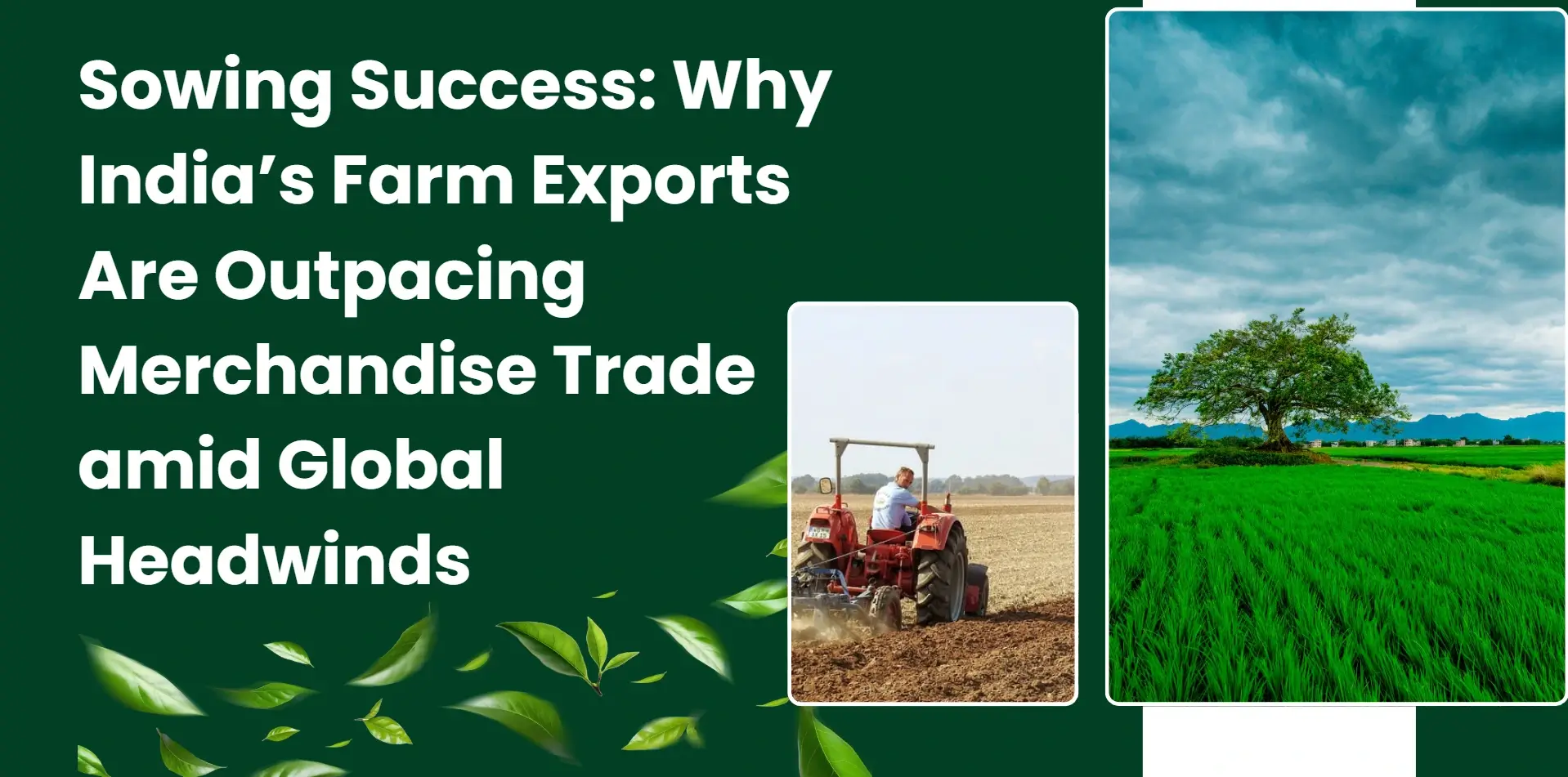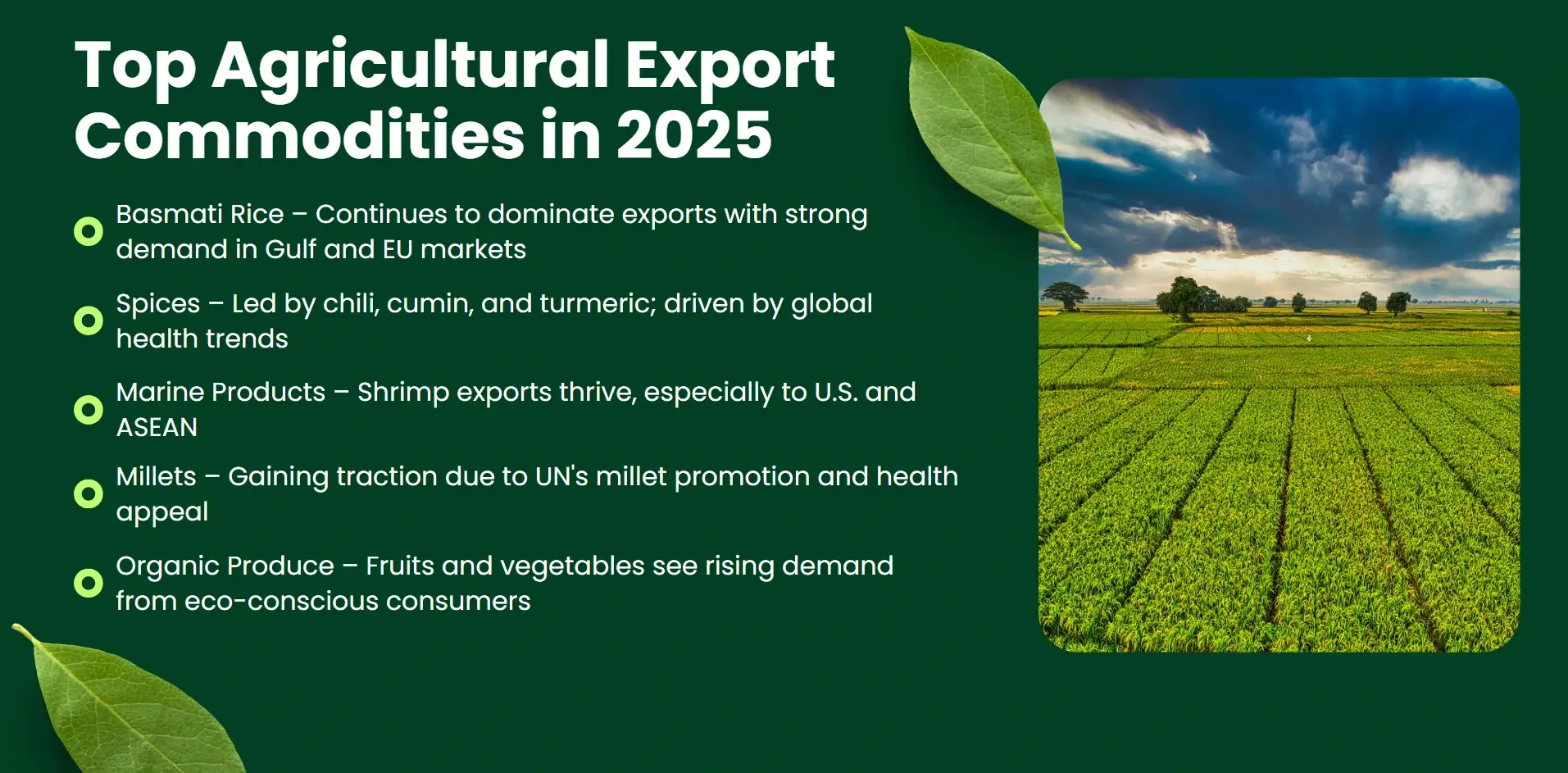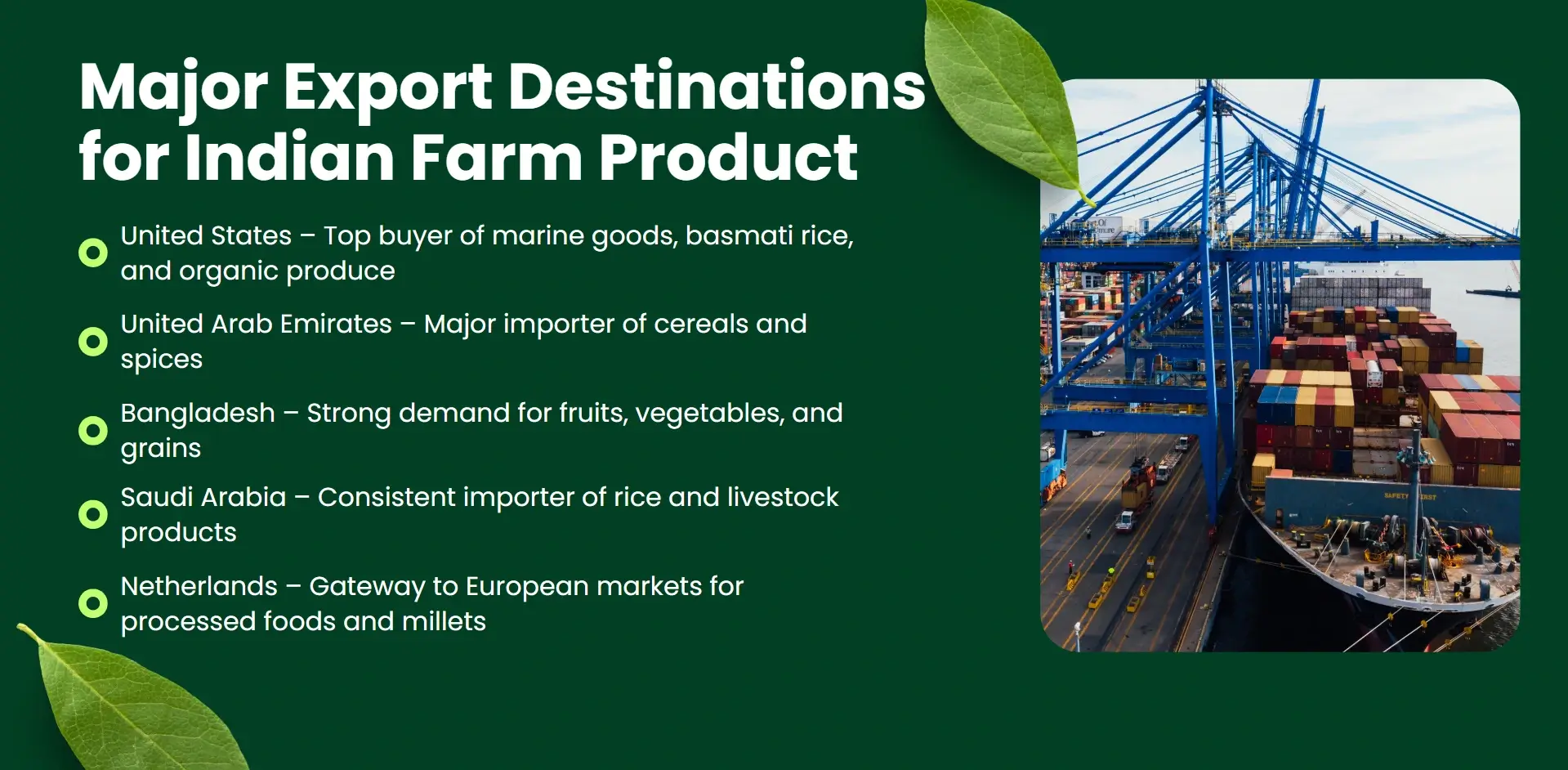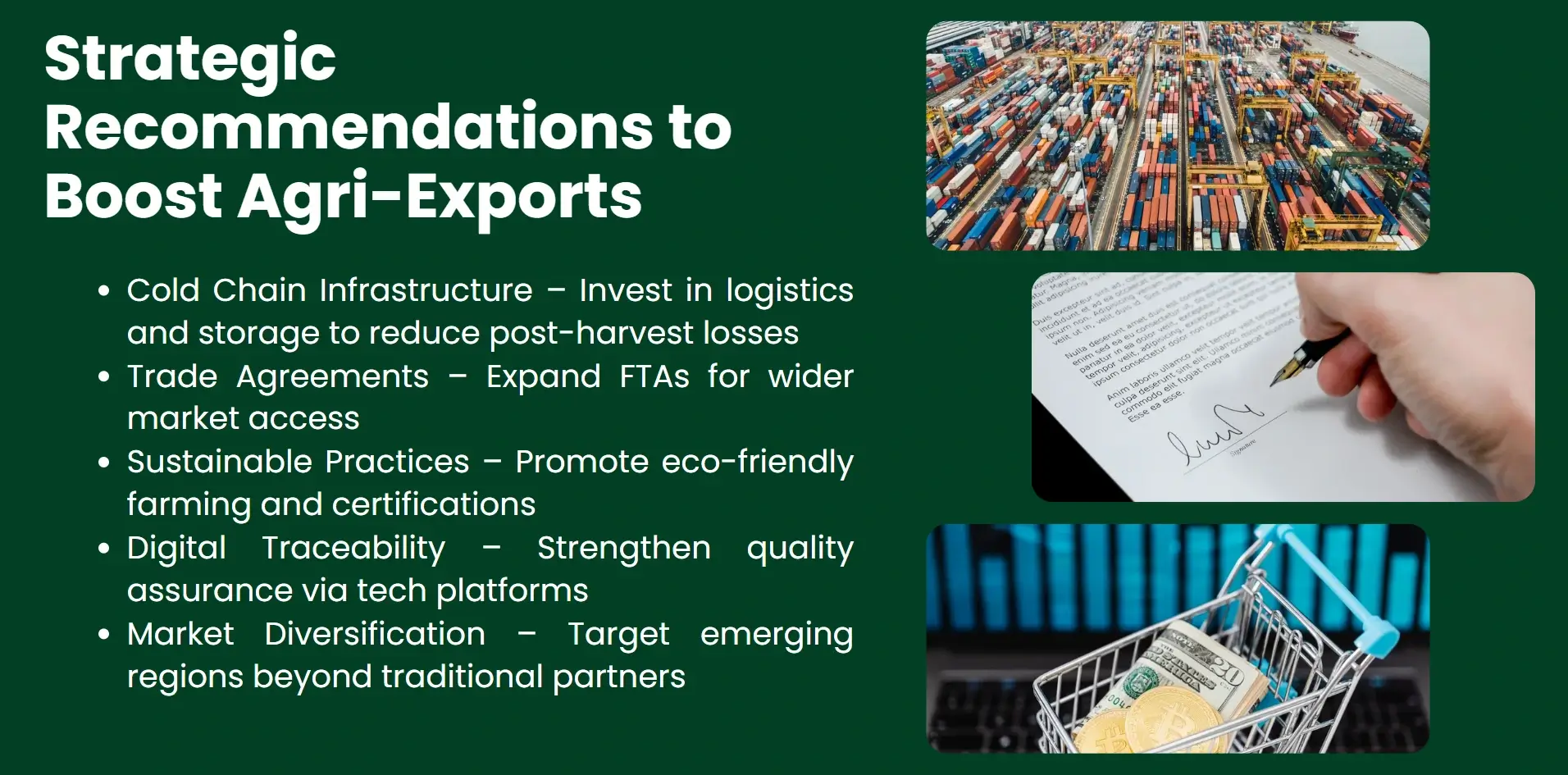Agricultural Exports:India's Agriculture Exports Surge 30%. The export growth of farm goods is also rising in India. During the current financial year (Apr. 2022 – January 2023), the agricultural exports have amounted to USD 43.37 billion, registering an increase of 6.04% over the exports of USD 40.90 billion during the corresponding period of the previous financial year i.e. April 2021 to January 2022. The overall trade of the country has been stagnant as the agricultural industry shows a greater resudence among the world slowdown and the possible risk that a re-emerging Trump government poses to it via tariffs.

Export economy in India is in a dilemma. Although total merchandise exports are levelling out due to worldwide economic uncertainty, clogged supply lines, and escalating supply chain issues,those connected to agribusiness are bucking the trend. India is all set to export a record-breaking amount of farm products in 2025 with strong harvests, soaring world food demand, and government strategic help. The agri-export basket of the country is growing in volume and value and consists of such products as rice, spices, seafood, and organic produce etc.Such a statistical dissociation between agriculture and merchandise trade goes beyond just being statistical as it shows structural strengths and weaknesses. The agricultural goods hold an advantage in that they are regarded as essential commodities and so, they are not so sensitive to economic fluctuations and geopolitical tensions. Not that it is all rosy, though. A reverse in the Trump-era tariffs, notably on major Indian products supplied to the American market, has the potential to pierce into this. Given that the U.S. is one of the biggest markets of some of these products such as basmati rice, mangoes, and shrimp, the possibility of uncertainty in the trade policy is high.This article examines the reasons why farm exports from India are performing better in comparison to other sectors, why is it growing, and how emerging geopolitical changes. By doing so, it emphasizes the new role of agriculture in external trade strategy of India as a stabilizer.
The Surge in Export of Agriculture
India's agricultural exports are experiencing a surge, particularly in the first quarter of the current fiscal year (2025-26), with a notable increase in exports to the US.Despite the grim outlook for the expansion of the merchandise trade, India's agricultural exports saw an unparalleled surge in 2025. This surge is the result of a confluence of structural, climatic, and policy-driven factors.

Good Weather and Great Crop Yields
Well-spaced monsoons during the last two years have also resulted in bumper crops of the main crops like rice, wheat, pulses, and sugarcane. Better irrigation coverage and climatic resistant agricultural activities have further stabilized the output. Because of this abundance India has been in a position to both satisfy the local demands and increase the level of exportation especially that of cereals and horticultural produce.
Increasing world demand of food security
Other areas where crops have failed due to climatic factors and the disruption that has been caused by the post pandemic have increased global demand on food suppliers that can be relied upon. African, Southeast Asian and Middle East countries rely more and more on India as the source of staples and processed foods. Global shift to food security has moved India to be a reliable food commoditiesexporter.
Export facilitation and Government Incentives
There has been a catalytic role played by policy interventions. Projects such as Agriculture Infrastructure Fund and the PM-PRANAM have enhanced logistics, storage and productivity at the farm level. The Agricultural and Processed food product export development authority (APEDA) have simplified the certification and export processes which makes accessing the international markets by the small producers easier. There are export subsidies and ease of compliance that have continued to encourage exports.
Value addition and Diversification
Agri-export basket of India is no more restricted to raw produce. There is a sharp increase in the demand of organic products, ready to eat meats, and nutraceuticals. Millets, which have been announced as Shree Anna have become popular around the world because of their nutritional status. This move to value-added and niche has led to improved competitiveness of India as well as command of prime prices in the international markets.
Merchandise Exports
There is evidence that India is in danger of poor performance in its merchandise exports, which had been a major driver of growth in the economy. Although there will be individual sectoral gains, the general trend will either be stagnant or negative in terms of growth in 2025.
Sectoral Headwinds and Bland Global Demand
Conventional export industries such as textiles, engineering products and electronics are struggling with the problem of dwindling demand in the global markets. Consumer spending, especially when it comes to discretionary items, has been low due to a high inflation rate and an increase in interest rates in key economies. The Indian exporters are experiencing dwindling order books of the European and North American markets, and this is coupled with increased competition caused by the emergence of low-cost manufacturers in the Southeast Asian region.
Supply Chain Disruptions and Inflation of Input Costs
Continued supply chain obstruction due to a lack of containers or queues at docks has added lead times and dilapidated margins. Also, due to the increased cost of input in particular energy and raw materials, Indian goods lost their competitive advantage in the international markets. Producers are finding it hard to make up such expenses without transferring them to the consumers, resulting in diminished profitability and export volumes.
Limitations of trade Diversification and FTA gaps
The merchandise exports of India are still highly dependent on some of its markets, especially the U.S., EU, and UAE. There are also no extensive free trade agreements (FTAs) with major economies, which have limited access to the market and tariff preferences. As negotiations take place, the sluggishness of trade diplomacy has placed Indian exporters at a disadvantage as they are outcompeted by those countries where there are stronger bilateral relations.
Lagging Technology and Quality Conformance
India is having difficulties in fulfilling world standards and certifications in high-tech sectors. There is a low level of R&D spending and a low rate of adoption of high-tech manufacturing technologies, which undermines competitiveness. In addition, the emerging environmental and labor requirements in the export markets have turned out to be a liability to the small and medium businesses.
Comparative Analysis
India has experienced a significant surge in agricultural exports, growing nearly sevenfold from $7 billion in 2003 to $49 billion in 2023. This growth is driven by increased global demand, strategic government initiatives, and improved agricultural practices.At a time when the merchandise exports are under pressure, the agricultural exports by India have been surprisingly strong. This difference is as a result ofbasic conflicts in the patterns of demand, the structures of production and geopolitical sensitivities.
Inelastic Global food demand
Agricultural commodities as compared to industrial goods, satisfy the fundamental needsof the human population. Food demand at global level is not very sensitive to recession in the economy. Be it rice, wheat or pulses, chances of climacteric driven by consumer sentiment or discretionary spend are less subject to these factors. This natural inelasticity protects the farm exports against the volatility that casts its evil spell on merchandise trade.

Less Reliance on Complex Supply Chains
The Indian agricultural production is not dependent on imported factors or sophisticated equipment as much as it is dependent on local materials such as land, labor, and use of local fertilizers. By contrast, the export of merchandise is frequently vulnerable to the international network of semiconductors and special components and energy-intensive manufacturing. This lessens the farm exports' vulnerability to a geopolitical embargo or shipping intrusion.
Geopolitical Neutrality and Trade Perception
The foods are normally considered as humanitarian and non-political, as compared to strategic commodities like electronics or military commodities. As they have a neutral image in the international markets, Indian agricultural products are less prone to trade barriers or even to secluded relations. It depends on the politically tense landscapes that countries will, in most cases, ensure that the channels of food import are not suspended, therefore, sustaining the agri-trade.
Simpler Compliance and Certification
Whereas merchandise exports are often associated with highly complex certification in the form of technical standards, safety protocols and environmental audits, agri-exports are associated with simpler phytosanitary checks and origin documentation. Compliance has additionally been facilitated by the help of the government, especially by APEDA and systems of traceability in digitalized format which enable small producers to enter into international trade.
Trump Tariff Factor
Most Indian exporters have said they can barely absorb a 10-15% rise, so a combined 50% tariff is far beyond their capacity. India's exports to the US face a 50% tariff due to President Trump's recent moves, affecting about 55% of merchandise exports.With farm exports great and growing, there is a possible headwind to worry about: The resurgence of Trump-era tariffs. These have the potential to redefine the trade scenario in India, much especially the markets of the country which are its prominent exporters of agricultural products.
Potential Return of Protectionist Policy
Following the political returning of US president Donald Trump, the speculation of resurgence of aggressive tariff policiesalso rose. His previous administration enforced the tariffs (duties) on steel, aluminium, and some agricultural goods under the pretext of saving the American jobs. Given the re-introduction of similar measures, there may be new barriers in the exports of India especially to the U.S depending on the volume and profitability.
Sensitive Agri-Exports
India exports a higher amount of agri-goods to the United States. These goods have taken niche markets in diaspora markets and wellness consumers. Nevertheless, they are also exposed to an increment in tariffs, non-tariff barriers, plus, more stringent sanitary regulations. Indian goods would struggle to compete with Latin American or Southeast Asian goods in case of an even moderate expansion of tasks.
Trade Diplomacy and Leverage on WTO
India can probably re-align its trade diplomacy by preparing against probable tariff shocks. It may be essential to use bilateral talks with consideration of the WTO frameworks and invocation of dispute resolution mechanisms. History has already demonstrated that India has been able to counter unfair trade practices but the procedure has always been slow and politically charged. Instead, taking the initiative to meet with U.S. trade officials and lobbying as the diaspora networks can be instrumentally advantageous.
Strategic Buffer as Diversification
In order to counter the risk, India has to expedite the agri-export diversification of destinations. The overdependence on the U.S. market can be curtailed by stepping up relations with the ASEAN countries, Africa, and the economies in the Middle East. Also, the Indian products may be branded and quality-certified to enjoy premium prices, which would compensate for any lossesincurredas a result of tariffs.
Policies and strategic directions
In order to maintain the agricultural export momentum and to ensure itself against external shocks, India has to have a forward-looking strategy. This entails the process of improving the infrastructure, diversification of the market, and institutional reforms, giving way to the global dynamics.India has seen a significant surge in agricultural exports, with policies and strategic directions focused on diversifying export baskets, promoting high-value products, and enhancing market access. The country aims to double agricultural exports by 2022 and further increase them to $100 billion in the coming years, driven by a stable trade policy regime, according to the Ministry of Commerce and Industry.
Fortifying Export Infrastructure and Logistics
Lack of proper cold chains, a disjointed transport system, and insufficient warehousing tend to limit the potential of exports in the agri sector in India. The development of rural logistic infrastructure and multimodal transportation, further supported by well-invested temperature-inspected warehouses,is going to minimize post-harvest losses and can enhance the quality of the products. The better connection to ports and border trade points will enhance the turnaround time and also reduce the costs.

Having More Export and Trade Agreements
It is necessary to minimize the dependence on conventional markets such as the U.S and the EU. India must aggressively seek trade treaties with countries that are emerging economies, like in Africa, Central Asia and Latin America. These are areas where the markets are increasing demandforstaple foods, processed food, and organic food. The important issues to be addressed by bilateral and regional FTAs would include tariff concessions, streamlined customs requirements and mutual recognition of standards.
Advancing Sustainable Climate-Resilient Agriculture
International consumers are more and more focused on buying products that have sustainable credentials. India can take advantage of this climatesmart agriculture, organic certification and regenerative farming. The visibility can be increased and premium prices can be received through branding programs done by positioning the millets as Nutri-cereals or promoting GI-tagged products. To encourage farmers to adopt environmentally friendly practices, government schemes must provide incentives to farmers in line with the objective of promoting exports.
Use of Digital Tools in Traceability and Compliance
Transparency and trust can be increased through digital systems, farm-to-port traceability, blockchain-based certification, and AI-powered quality screening. They assist in achieving phytosanitary standards and promoting ethical crop practices, particularly in high-value markets. Digital literacy levels will become an important scaling factor once trained among exporters and farmers.
Conclusion
The agricultural export experience of India in 2025 can be cited as the light in the dark of a slow international trading world. Here, when merchandise exports contend with structural inefficiencies and disruptions in the global supply chain, geopolitical uncertainties, and economic resurgence, farm exports are flourishing,fuelled by stronger production, increased food demand globally and focused policy priority. This disparity highlights the strategic value of agriculture beyond the needs of rural life, the aspect that helps to make India economically stable.Nevertheless, not everything lies open on the way ahead. Future trade disruptions may come in the reintroduction of Trump-era tariffs, which can hurt important agri-export routes to the U.S. In order to protect gains, India has to invest in infrastructure, diversify markets and adopt sustainable and tech-enabled agriculture processes. Through active diplomacy and re-engineering, India has the potential of transforming its agricultural sector into a proactive exporter so as to assume leadership in the world on food security and climate-resilient trade. There is no time to waste before external shocks can come along to quench this hard-earned momentum.